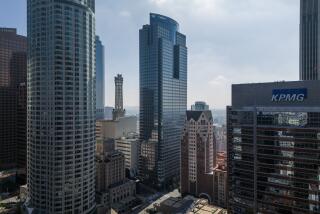Health Risk of Aeration Tower Called Insignificant
- Share via
State health officials have concluded that chemical vapors from an aeration tower in North Hollywood, which the city wants to build to clean up tainted well water, would not pose a significant health risk.
Even a person who spends a lifetime living and working near the proposed tower site at 11845 Vose St. would not raise his risk of getting cancer by more than one chance in 1 million, says a letter from the state Department of Health Services to the South Coast Air Quality Management District.
Chemical emissions from the tower would be too diluted to cause short-term toxic effects, says the letter, which was signed by state health epidemiologists Norman Gravitz and Michael J. Lipsett. Although there is a child-care center within one-quarter mile of the site, potential “worst-case exposures” are 1,000 times too low to cause acute toxic effects, the letter said.
Permit Considered
The air district is considering a request by the Los Angeles Department of Water and Power for a permit to operate the 45-foot aeration tower, which would purge chemical solvents from underground drinking-water supplies through evaporation.
The air district in December granted a request by several nearby property owners to hold a public hearing before ruling on the permit, but it held off scheduling the hearing until state health officials could review a risk analysis by DWP consultants.
With the heath department’s opinion in hand, the air district has scheduled the public hearing for 6 p.m. May 12 at Fair Avenue School, 6501 Fair Ave., North Hollywood.
Laurent McReynolds, DWP assistant chief engineer for the water system, said the state health analysis confirms his department’s view “that the risk is insignificant.”
But one businessman less than a block from the city-owned site said he is not convinced that the project is safe.
One Who Sought Hearing
“Who knows? I’m not a scientist,” said Herb Ginsburg, who owns a linen and curtain manufacturing firm on Radford Avenue, next to the city property, and is one of those who sought a public hearing. If tiny amounts of chemicals were no cause for concern, “they wouldn’t have to get the stuff out” of the water, Ginsburg said.
The aeration, or air-stripping tower, essentially converts low levels of chemicals in water into lower concentrations in air.
The device cleans water by accelerating the natural tendency of solvents to evaporate. Water is pumped from polluted wells to the top of the tower and blasted with a stream of air, causing nearly all of the pollution to leave the water in vapor form.
The $2.2-million project is aimed at slowing the advance of industrial cleaning compounds--particularly trichloroethylene and perchloroethylene--that are gradually seeping into more of the eastern San Fernando Valley ground-water wells that furnish 15% of the city’s drinking water.
About 35 of these wells exceed state recommended limits for TCE or PCE pollution. The city has kept some of the tainted wells in service by blending them with fresh supplies, but others have been shut down because contaminant levels are well above state advisory limits.
DWP officials say the highest solvent levels in the air around the tower will be in the parts per trillion range--or roughly 1,000 times less than the highest concentrations in ground water.
Despite the extremely small airborne concentrations, the tower could emit up to 3.7 tons of solvent vapors a year, or about 20 pounds a day, according to DWP data. However, DWP officials point out that the average dry-cleaning establishment, which uses PCE to clean clothes, puts out the same amount of vapor.
In pushing for the aeration tower, the city has rejected two more expensive alternatives that would essentially eliminate air emissions while increasing waste disposal problems.
Cost of Filters
One alternative would be to install carbon filters on the tower to trap the vapors--although the spent filters might have to be disposed of as hazardous waste. Using filters to halt air emissions might cost only $20,000 to $30,000 each year, but the DWP contends that the cost is unreasonable because the uncontrolled emissions won’t damage health.
The DWP also has rejected direct carbon filtering of tainted water in place of aeration, arguing that this alternative would be 2 to 3 times more expensive.
The DWP has applied to the U.S. Environmental Protection Agency for a $250,000 grant to experiment with an ultraviolet water treatment process that would avert air emissions.
The air-stripping tower, which could be operating by the end of 1987, would treat about 2,000 gallons of water a minute, or about 1 billion gallons a year.
More to Read
Sign up for Essential California
The most important California stories and recommendations in your inbox every morning.
You may occasionally receive promotional content from the Los Angeles Times.













